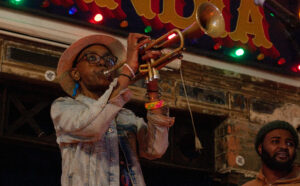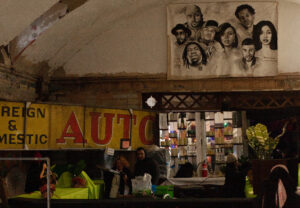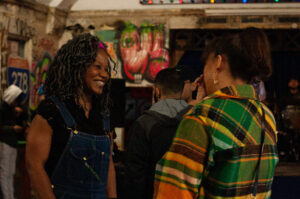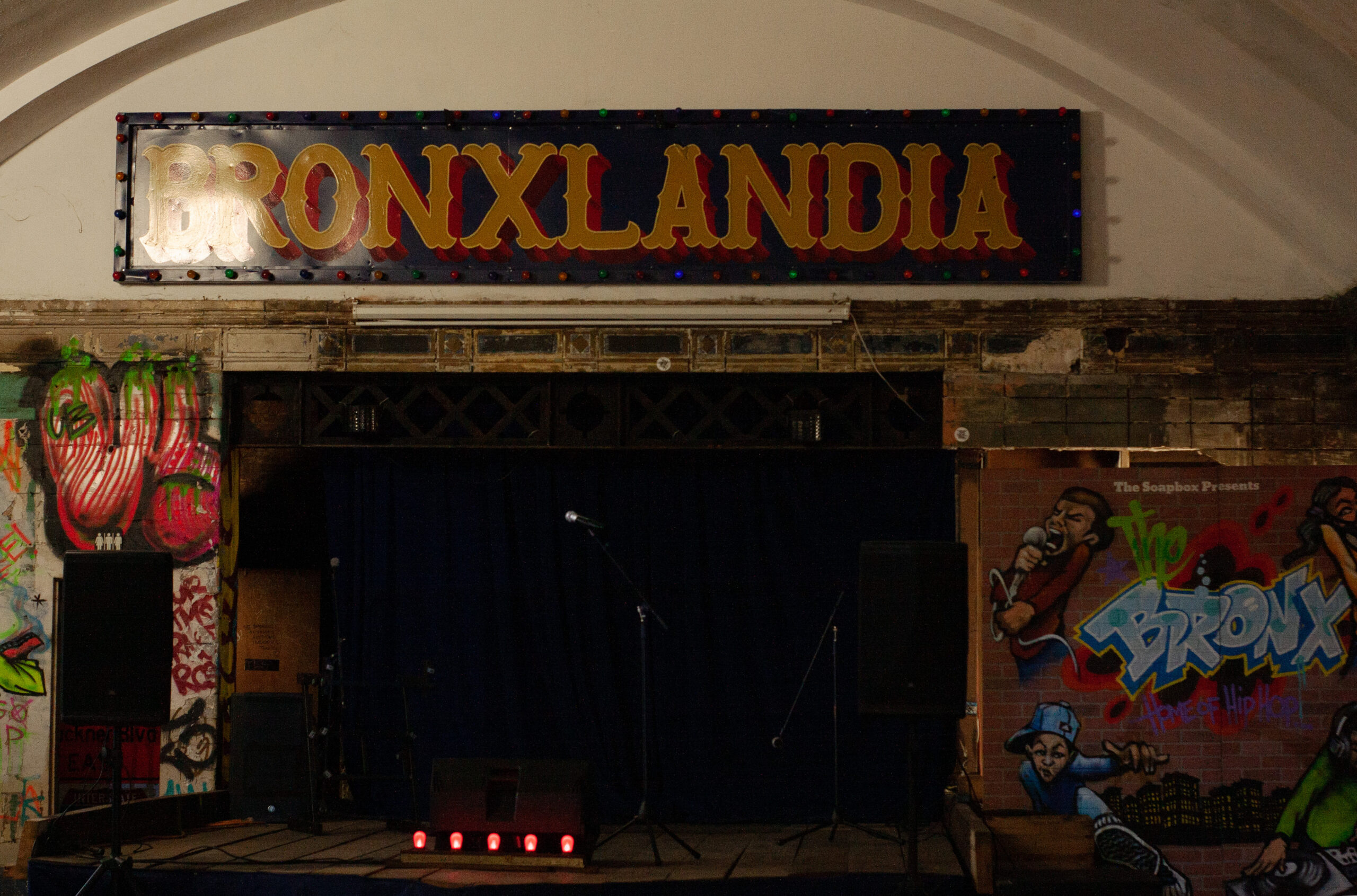Bronxlandia opened for the first time this season on March 25, with a jazz-rock performance by musicians Angeleisha Rogers, Gervis Myles, and Tim Angulo, amongst others, as the nightcap for the Boogie Down Crawl for Change, a day-long crawl through six South Bronx businesses.
Bronxlandia, a performance and event venue, is the new iteration of a century-old Hunts Point train station ,spearheaded by South Bronx-born entrepreneur Majora Carter. The space is part of her mission to show Bronxites that local talent and entrepreneurship doesn’t need to leave the borough to thrive.
The structure, as befits an early train station, has tall ceilings and a long hall of open space. Today, those dimensions create resonant acoustics for musical performances, which is a bonus that the owners Carter and her partner, James Chase, says they did not expect.
When they purchased the building from Amtrak in 2016 for just $1, the building was cluttered with dividing walls for prior storefronts and an attic apartment.
“This place fills with sound very well, which we didn’t know when we got this place,” said Chase. “When we’re playing music so loud in here that you could hardly have a conversation, we’ve never got a 311 complaint from this place.”

The building is a historic beauty, with arched windows and a ground level entry, that the owners operate through rentals for performances and events. In the past, those have included the nationals of the regional Northeast break dancing competition, wrestling matches by Invictus Pro Wrestling, the Hip Hop Vintage Flea Market, local school events, Ted Talks, music video shoots, and even one party that brought a mechanical bull.
“The whole crash area was an inflatable, bouncy house material, and they had the whole thing set up in 15 minutes, and the bull was ready. We’ve had pro wrestling where there was a 16 by 16 ring in the middle,” said Chase.

The space, which lacks air conditioning and heating, is a seasonal operation that hosts events on a temporary, by-the-basis schedule. Last year, the owners held more than 30 events and rely on Carter’s additional business, a hip-hop cafe called Boogie Down Grind, just one block up on Hunts Point Avenue, to make sales and sustain the business.
The former train station was built by architect Cass Gilbert in 1909, and went through a series of transformations in the last century before Carter finally bought it with the vision for Bronxlandia.
It was one of nine train stations built in the Bronx by The New York, New Haven, and Hartford Railroad Company in the early 1900s. The station is French Renaissance in design, with truss metal reinforcements of its concrete roof and red brick walls faced with stucco, which according to a Lehman College page, means the station was built to last.
In the late 1930s, Chase said, the station was developed into retail storefronts, which later were leased by Amtrak to the owners of El Coche strip club from the 1970s through the 1990s.
“It was dismal in the ways that you expect those kinds of places to be,” said Chase. “But when we were doing the demolition here, we found decorations for every holiday of the year, and photos of the owner and bartender and the people and the strippers, posing for some kind of family picture, so there was love or something like it.”
It was after the strip club closed and the area became filled with junk – like collapsed dividing walls and a sealed attic apartment – that Carter found potential in the space.

“We used to call it the mines because it was so dark and so filthy, we always had to put on a respirator,” said Chase. “We had pickaxes and sledgehammers, and I would hire even more guys to ferry it all out.”
Renovating the space has brought significant financial challenges, Chase said, because of the debris and also the location of the former station, which is right under the Bruckner Expressway on a bridge. A location without much land makes banks more hesitant to approve loans, since there would not be much land to repossess if the loan were not returned.
“It inhibits a bank from loaning money into the situation because if we can’t pay, they don’t have anything to repossess,” Chase said. “Majora bought it for a dollar, but it needs $2 million worth of work, so financing that is a huge challenge.”
Carter insists that it’s important for Bronx entrepreneurs to set up in the Bronx so that people, and especially youth, can see that the borough is not a place they need to leave with their talents to thrive.
“People need a place where there are people around them that they can aspire to be,” Carter said, and added, “emotionally, if you don’t have the kind of place that makes you feel great about where you are, you will figure out a way to get away from it.”
Carter’s own journey as a Bronx-born entrepreneur began as a high school student in the 1980s, who every day passed by what used to be a crack house, and internalized the message that for her to find success, she would need to leave the Bronx.

“All it did was cement in my mind how far I needed to get away from my neighborhood, because I was a smart kid,” Carter said, but now, she says she sees the potential and rewards of reinvesting Bronx talent into the neighborhood to make it a place people don’t want to run from. Now, a photo of that house hangs on the wall of her cafe as a reminder of how far the Bronx has come since the 1980s.
“Think years of systemic racism, and bias against communities like ours that makes it difficult for us to get access to capital, the kind of things that we need to grow and build,” Carter said.
She left the Bronx for school but returned when she needed a cheap place to stay. Once she was reacquainted with her neighborhood, she began work in park development and spearheaded Hunts Point Riverside Park, which opened in 2006 and won the Rudy Bruner award for Urban Excellence.
Carter then founded The Bronx Environmental Stewardship Training Program, an urban green collar program that helped South Bronx residents see the personal and financial stakes in improving their neighborhood.
“Real estate or home ownership, but also business development, it was about people in our community owning assets and creating the kind of community where people felt like they didn’t have to move out of their neighborhood to feel like they were living in a great one,” Carter said.
Last year, Gov. Kathy Hochul included the Hunts Point Rail station in a list of 21 recommendations for state-designated historical sites, and said she hopes historical recognition might provide more city resources to the building.

